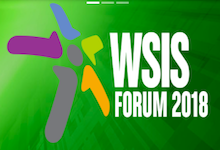The make listening safe initiative
19 Mar 2018 13:15h - 14:00h
Event report
[Read more session reports from the WSIS Forum 2018]
This session, moderated by Mr Simão Campos, counsellor of the Study Group 16 of the International Telecommunication Union Telecommunication Standardization Sector (ITU-T), shed light on the World Health Organization (WHO) and ITU partnership for the ‘Make Listening Safe’ initiative.
Ms Shelly Chadha, technical officer at WHO Prevention of Deafness and Hearing Loss, explained the reasons behind hearing loss and shared safe listening practices. Chadha emphasised that, by 2050, nearly one out of every 10 people will experience disabling hearing loss. The factors include certain infections, genetic predispositions and, more importantly, exposure to noise across the course of one’s life. Noise-induced hearing loss is the second most common risk factor encountered in the workplace. Chadha provided best practices such as reducing volume and limiting the amount of time spent listening to loud sounds. She also stressed the use of noise-cancelling earphones and apps which assess sound levels, both on the device and in the environment. Chadha explained how the WHO initiative – Make Listening Safe – draws attention to the rising problem of noise-induced hearing loss and partners with the ITU to bring together governments, health professionals, academia, and industry to discuss how ICTs can help make listening safe. Expected outcomes include policy briefs, international standards, and awareness campaigns.
Chadha clarified that, through this partnership with the ITU, WHO aims to:
- Raise awareness among listeners, policymakers, and civil society
- Make sure suitable and safe products are available to listeners
- Make sure the environment is safe for the target audience
- Design safe regulations so that the user who wants to listen safely at a venue can have that option
Chadha concluded that technologies such as smartphones are part of the challenge and can be a causative factor in hearing loss but can also be part of the solution by making them compatible with risk reduction rather than risk augmentation.
Mr Masahito Kawamori, rapporteur of Question 28 of ITU-T Study Group 16, dealt with safe listening standards for personal audio systems. Kawamori focused on what he called ‘dosimetry’, the measurement of ‘sound dose’, and argued that there should be stricter requirements especially for young children as compared to adults. He highlighted the importance of health communication, as it includes risk information on hearing loss, usage information to make personal listening profiles through a dosimeter, and concrete recommendations for safe listening.
By Ines Hfaiedh
Related topics
Related event

